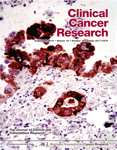The cause of pancreatic cancer is still unknown, although there are risk factors involved, such as increased exposure to tobacco smoke and a family history of the disease. It is usually detected late when advanced stage disease has set in because most patients are asymptomatic for a long period and then it is too late. This raises the question of how can we learn and understand more about the biology of the disease as well as develop early warning signs via biomarkers used in screening?
It was therefore fascinating to be browsing through the latest edition of the New England Journal of Medicine over coffee this morning to discover an article on the medical progress in pancreatic cancer while simultaneously noticing an item on a new potential biomarker for the disease in Twitter! The NEJM review hasn’t been published online yet, so I’ll add the reference later.
Essentially, the NEJM article reviewed the biology of what we know of pancreatic cancer so far:
- Results from successive accumulation of gene mutations (average of 23 per tumour)
- Most patients with malignant disease carry 4 or more mutations (eg KRAS, CDKN2A, TP53, DPC4)
- It’s extremely heterogeneous (more difficult to treat)
- Formation of dense tumour stroma (dermoplastic reaction)
- It is poorly vascularised (due to stellate cells and activation of TGFβ1, PDGF and FGFR)
- Poor prognosis and treatment resistance has been conferred by the presence of cyclooxegenase-2 and PGFR, VEGF, SPARC and Hedgehog overexpression to name a few
The poor vascularisation of the tumour may well explain why anti-angiogenic therapies have not yielded promising results in the clinic to date.
Treating advanced cancer is always more difficult than earlier cancers in the neoadjuvant and adjuvant settings. The big challenge with pancreatic cancer to date, though, has been finding useful biomarkers for earlier detection, which would most likely impact outcomes for the disease. According to the NEJM article:
“The overall 5-year survival rate among patients with pancreatic cancer is <5%.”
That’s a pitiful number that needs to change.
 There are a number of agents in the clinic for the treatment of advanced pancreatic cancer including inhibitors of SPARC, MEK, Mucin-1, IGF-1R, Hedgehog, PDGF and FGFR, Src, RAS, JAK-STAT and TNFα, for example.
There are a number of agents in the clinic for the treatment of advanced pancreatic cancer including inhibitors of SPARC, MEK, Mucin-1, IGF-1R, Hedgehog, PDGF and FGFR, Src, RAS, JAK-STAT and TNFα, for example.
Many of these agents are looking at single agent studies or in combination with the current standard of care, gemcitabine, itself with limited effectiveness. It is, therefore, quite hard to imagine that blocking one pathway alone is likely to be the panacea for such a hard to treat and highly complex cancer, as the graphic to the left shows (click to see the detail).
Source: Genway Bio
Meanwhile, progress may be possible on the detection front. Goicoechea et al. reported in PLoSONE that a type of protein called “palladin” is produced in large amounts in groups of cells in the stroma surrounding pancreatic tumours, known as the ‘tumour nest’. By measuring the levels of palladin in patient samples, doctors could have an improved way to screen for the disease, potentially detecting it earlier than current tests.
However, I say potentially, because these findings while interesting, need to be validated in large scale phase III clinical trials before we can really be certain of their long term validity. Nevertheless, it is a promising start for a devastating disease.
If there was one cancer that would hugely benefit from better earlier detection and diagnosis, it’s pancreatic cancer. We need more cowbell. That is all.
 Update October 12, 2012
Update October 12, 2012
Another interesting paper on the biology of pancreatic cancer that is worth looking at if you are interested in this area is by Manuel Hidalgo and Daniel Van Hoff and was published earlier this year in the August 15, 2012 issue of the AACR journal Clinical Cancer Research.
Entitled, “Translational Therapeutic Opportunities in Ductal Adenocarcinoma of the Pancreas“, the full paper is currently available for free!

Goicoechea, S., Bednarski, B., Stack, C., Cowan, D., Volmar, K., Thorne, L., Cukierman, E., Rustgi, A., Brentnall, T., Hwang, R., McCulloch, C., Yeh, J., Bentrem, D., Hochwald, S., Hingorani, S., Kim, H., & Otey, C. (2010). Isoform-Specific Upregulation of Palladin in Human and Murine Pancreas Tumors PLoS ONE, 5 (4) DOI: 10.1371/journal.pone.0010347
